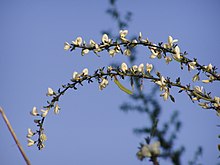Cytisus multiflorus is a species of legume known by the common names white broom,[3] white spanishbroom[4] and Portuguese broom.[5]
| Cytisus multiflorus | |
|---|---|

| |
| Scientific classification | |
| Kingdom: | Plantae |
| Clade: | Tracheophytes |
| Clade: | Angiosperms |
| Clade: | Eudicots |
| Clade: | Rosids |
| Order: | Fabales |
| Family: | Fabaceae |
| Subfamily: | Faboideae |
| Genus: | Cytisus |
| Species: | C. multiflorus
|
| Binomial name | |
| Cytisus multiflorus | |
| Synonyms[2] | |
|
List
| |
Distribution
editIt is native to the Iberian Peninsula, especially frequent in the western half in central and northern interior Portugal[6] and central and northern western Spain.[7] It is better known as an introduced species on other continents, including Australia and North America, where it has become a weed in agricultural land and an invasive species in natural habitats.
Description
editCytisus multiflorus is a shrub growing up to 0.8 metres (2 ft 7 in) or 1.5 metres (4 ft 11 in) in sprawling height,[7] with a broomlike array of many five-angled flexible branches. Leaves appear mainly on lower branches, each made up of three leaflets. Some leaves grow on the upper branches; these are generally made up of a single leaflet. Each leaflet is under a centimeter long and may be linear to oblong in shape and coated in soft silvery hairs.
The white, pea-like flower is up to a centimeter long and is often marked with a dark pinkish streak near the base. The fruit is a hairy legume pod up to 3 centimetres (1.2 in) long. The pods turn black with age and dehisce explosively to release their four to six seeds away from the parent plant.
Invasive species
editThis plant is a serious noxious weed of agricultural fields and a colonizing invasive plant in wild lands in parts of Australia and California,[8] where it was first introduced as an ornamental shrub for its prolific white flowers. It is still sometimes grown and sold for landscaping purposes despite its status as a pest plant, with new industry and public education programs resulting.[9][10]
Gallery
editReferences
edit- ^ Rivers, M.C. (2017). "Cytisus multiflorus". IUCN Red List of Threatened Species. 2017: e.T83750589A86135941. doi:10.2305/IUCN.UK.2017-3.RLTS.T83750589A86135941.en. Retrieved 20 November 2021.
- ^ "The Plant List: A Working List of All Plant Species". Retrieved 3 April 2014.
- ^ BSBI List 2007 (xls). Botanical Society of Britain and Ireland. Archived from the original (xls) on 26 June 2015. Retrieved 17 October 2014.
- ^ USDA, NRCS (n.d.). "Cytisus multiflorues". The PLANTS Database (plants.usda.gov). Greensboro, North Carolina: National Plant Data Team. Retrieved 17 January 2016.
- ^ "Cytisus multiflorus (L'Her.) Sweet". Catalogue of Life. Retrieved 28 March 2021.
- ^ "Cytisus multiflorus (L'Hér.) Sweet". Flora-On. Retrieved 28 March 2021.
- ^ a b "Cytisus multiflorus" (PDF). Flora Iberica. Retrieved 28 March 2021.
- ^ Jepson
- ^ "Weeds in Australia" (PDF). Australian Weed Management. Archived from the original (PDF) on 16 February 2011. Retrieved 24 November 2010.
- ^ "What are invasive species and why are they a problem?". Calif. Invasive Species Program. Retrieved 24 November 2010.
External links
edit- Media related to Cytisus multiflorus at Wikimedia Commons
- Jepson Manual Treatment – Cytisus multiflorus (introduced species)
- "Cytisus multiflorus". Germplasm Resources Information Network. Agricultural Research Service, United States Department of Agriculture.
- Cal-IPC: California Invasive Plant Council – homepage
- Cytisus multiflorus – Photo gallery
